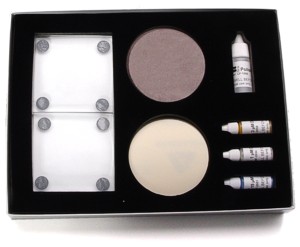Electrode Polishing
A well-polished working electrode is absolutely essential for collecting reliable data from CVs. Working electrodes should be polished immediately before use, because even a few hours exposure to air will degrade the quality of the electrode surface and inhibit electron transfer, resulting in strange features on the CV.
Mechanical Polishing
As was previously mentioned, the working electrode must be polished to ensure that there are no surface contaminants that might interfere with electron transfer. One common way of polishing the working electrode is using a commercially available polishing pad and alumina (Al2O3). The alumina is mixed with water on the polishing pad in order to make a paste. The working electrode is then rubbed on the polishing pad with some alumina paste while ensuring that the face of the working electrode is flat and polishing is performed in a figure-8 so that grooves do not develop in the electrode surface. After polishing for about 30 seconds, the electrode should be sonicated in deionized water for no more than 1 minute (sometimes the electrical connections within the electrode are delicate). Sonication removes any alumina that may have adsorbed to the electrode surface. After washing with more deionized water, the electrode can be used in aqueous electrochemistry. If the electrode is to be used for non-aqueous electrochemistry, trace water from the sonication bath can be removed with methanol, and methanol can be removed with a blast from canned air. Wiping the surface of the electrode with a tissue or kimwipe may be sufficient to remove trace methanol, but there is a risk of scratching the surface of the electrode.

hover over pic for description
Electrochemical Polishing
Not all electrodes are able to be polished mechanically. Metal meshes, gauzes, and foams, and rods can be polished by cycling the potential so that the potential window extends just beyond both sides of the solvent window (the range where the solvent is stable to the electrode potential) at 1 V/s. The same technique can be used to clean carbon electrodes, but sweeping to extreme positive potentials in the presence of water may result in oxidation the electrode surface and should be avoided.
Conditioning of Metal Electrodes in Water
Common working electrode materials, such as gold and platinum, get covered by a layer of oxide at high (positive) potentials and by a layer of hydrogen atoms (they “get hydrogenated”) at low (negative) potentials. In water, these electrodes have to be pretreated by cycling repeatedly across the entire solvent window in the electrolyte solution before the addition of analyte, until the CV traces over itself.



Did I earn one of these yet?

is licensed under a Creative Commons Attribution-NonCommercial-ShareAlike 4.0 International License.